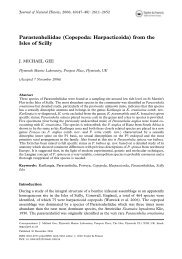An Updated Classification of the Recent Crustacea
An Updated Classification of the Recent Crustacea
An Updated Classification of the Recent Crustacea
Create successful ePaper yourself
Turn your PDF publications into a flip-book with our unique Google optimized e-Paper software.
(1996a–c), Rodríguez (1982, 1986, 1992), and<br />
Sternberg (1997), feel that <strong>the</strong>re is ‘‘strong support<br />
for <strong>the</strong> idea that <strong>the</strong> Pseudo<strong>the</strong>lphusidae and Trichodactylidae<br />
each form a natural group,’’ and<br />
Spears and Abele (1999) have suggested that <strong>the</strong><br />
pseudo<strong>the</strong>lphusids are deserving <strong>of</strong> superfamily status.<br />
Christoph Schubart (pers. comm.) also agrees<br />
that <strong>the</strong> former Potamoidea is polyphyletic, especially<br />
as concerns <strong>the</strong> South American lineages<br />
(families Pseudo<strong>the</strong>lphusidae and Trichodactylidae).<br />
Our classification is in keeping with most <strong>of</strong><br />
<strong>the</strong> above views.<br />
Thus, excluding <strong>the</strong> trichodactylids, we recognize<br />
three superfamilies <strong>of</strong> freshwater crabs: Potamoidea,<br />
Pseudo<strong>the</strong>lphusoidea, and Gercarcinucoidea.<br />
Within <strong>the</strong> ‘‘potamoid’’ families (superfamily Potamoidea),<br />
<strong>the</strong> families Sinopotamidae and Isolapotamidae<br />
have been removed, as both are thought<br />
to fall within <strong>the</strong> limits <strong>of</strong> <strong>the</strong> existing Potamidae<br />
(Ng, 1988; Dai et al., 1995; Dai, 1997; Dai and<br />
Türkay, 1997). Sternberg and Cumberlidge (1999)<br />
have recently recognized <strong>the</strong> monogeneric Platy<strong>the</strong>lphusidae<br />
Colossi, 1920, as a distinct potamoid<br />
family (see also Cumberlidge et al., 1999; Cumberlidge,<br />
1999) and at <strong>the</strong> same time suggested that<br />
<strong>the</strong> sister group <strong>of</strong> <strong>the</strong> platy<strong>the</strong>lphusids is most likely<br />
<strong>the</strong> East African family Deckeniidae. The Potamonautidae,<br />
considered to belong to <strong>the</strong> Potamidae<br />
by Monod (1977, 1980) and Guinot et al. (1997),<br />
is recognized as an independent family following<br />
<strong>the</strong> works <strong>of</strong> Ng (1988), Ng and Takeda (1994),<br />
Stewart (1997), Cumberlidge (1999), and Sternberg<br />
et al. (1999).<br />
Thus, within <strong>the</strong> superfamily Potamoidea, we<br />
recognize only four families here, all <strong>of</strong> <strong>the</strong>m Old<br />
World groups: Potamidae, Potamonautidae, Deckeniidae,<br />
and Platy<strong>the</strong>lphusidae.<br />
Superfamily Gecarcinucoidea<br />
Only two <strong>of</strong> <strong>the</strong> three families originally included<br />
in this superfamily by Bott (1970a, b) are recognized<br />
here: Gecarcinucidae and Para<strong>the</strong>lphusidae.<br />
The family Sunda<strong>the</strong>lphusidae has been removed,<br />
as that family is now considered a junior synonym<br />
<strong>of</strong> <strong>the</strong> Para<strong>the</strong>lphusidae (Peter Ng, pers. comm; see<br />
also Ng and Sket, 1996; Chia and Ng, 1998). The<br />
family Gecarcinucidae, although recognized as being<br />
artificial as currently defined and in need <strong>of</strong> revision<br />
(N. Cumberlidge, pers. comm.; and see Cumberlidge,<br />
1987, 1991, 1996a, b, 1999; Cumberlidge<br />
and Sachs, 1991), has been retained for now. Membership<br />
<strong>of</strong> <strong>the</strong> family, as currently defined, is likely<br />
to be altered radically in <strong>the</strong> near future (N. Cumberlidge,<br />
pers. comm.). For example, it is possible<br />
that <strong>the</strong> Gecarcinucidae will be shown to be restricted<br />
to <strong>the</strong> Indian subcontinent, Asia, and Australasia<br />
(see Cumberlidge, 1999; Martin and Trautwein,<br />
in press), and it is not represented on <strong>the</strong><br />
African continent, despite reports to <strong>the</strong> contrary<br />
(e.g., Bott, 1970a, b). Evidence for maintaining this<br />
superfamily (Gecarcinucoidea) and for separating<br />
<strong>the</strong>se two families (Gecarcinucidae and Para<strong>the</strong>lphusidae)<br />
from <strong>the</strong> four families in <strong>the</strong> Potamoidea<br />
is weak and controversial. Never<strong>the</strong>less, we are recognizing<br />
<strong>the</strong> distinctness <strong>of</strong> <strong>the</strong> Gecarcinucidae and<br />
Para<strong>the</strong>lphusidae from <strong>the</strong> four potamoid families<br />
until fur<strong>the</strong>r evidence becomes available.<br />
Superfamily Pseudo<strong>the</strong>lphusoidea<br />
Originally established by Bott (1970a, b) to include<br />
two families, Pseudo<strong>the</strong>lphusidae and Potamocarcinidae,<br />
this New World superfamily is now restricted<br />
to a single family. The family Potamocarcinidae<br />
was removed by Rodríguez (1982), and its<br />
species are now included among <strong>the</strong> Pseudo<strong>the</strong>lphusidae<br />
(see Sternberg et al., 1999). The monophyly<br />
<strong>of</strong> <strong>the</strong> family Pseudo<strong>the</strong>lphusidae appears<br />
well established. As noted above, Sternberg et al.<br />
(1999), citing <strong>the</strong> works <strong>of</strong> Magalhães and Türkay<br />
(1996a–c), Rodríguez (1982, 1986, 1992), and<br />
Sternberg (1997), feel that <strong>the</strong>re is ‘‘strong support<br />
for <strong>the</strong> idea that <strong>the</strong> Pseudo<strong>the</strong>lphusidae and Trichodactylidae<br />
each form a natural group.’’ Spears<br />
and Abele (1999) also have suggested that <strong>the</strong> pseudo<strong>the</strong>lphusids<br />
may be deserving <strong>of</strong> superfamily status,<br />
and most workers are in agreement that <strong>the</strong><br />
pseudo<strong>the</strong>lphusids are a natural (monophyletic)<br />
group (T. Spears, pers. comm.; C. Schubart, pers.<br />
comm.; Sternberg and Cumberlidge, 1999; Sternberg<br />
et al., 1999). We have retained this superfamily<br />
and its single family Pseudo<strong>the</strong>lphusidae.<br />
Superfamily Cryptochiroidea<br />
Finally in <strong>the</strong> Heterotremata, <strong>the</strong> correct name for<br />
<strong>the</strong> superfamily and family <strong>of</strong> <strong>the</strong> coral gall crabs<br />
(Cryptochiroidea and Cryptochiridae, both credited<br />
to Paulson) was recognized by Kropp and Manning<br />
(1985, 1987), who replaced <strong>the</strong> name Hapalocarcinidae<br />
used previously for this group.<br />
SECTION EUBRACHYURA, SUBSECTION<br />
THORACOTREMATA<br />
Superfamily Pinno<strong>the</strong>roidea<br />
C. Schubart (pers. comm.) believes that <strong>the</strong> Pinno<strong>the</strong>ridae<br />
‘‘should remain in <strong>the</strong> Thoracotremata<br />
based on evidence from DNA sequencing.’’ Placement<br />
<strong>of</strong> <strong>the</strong> pinno<strong>the</strong>rids in <strong>the</strong> Thoracotremata<br />
was also advocated by Števčić (1998) based on<br />
morphological features. Thus, <strong>the</strong> pinno<strong>the</strong>rids are<br />
moved to within <strong>the</strong> Thoracotremata, although <strong>the</strong><br />
author <strong>of</strong> <strong>the</strong> Thoracotremata does not agree with<br />
this placement (Guinot, pers. comm.) and feels that<br />
<strong>the</strong>y fit better within <strong>the</strong> Heterotremata. Within <strong>the</strong><br />
Pinno<strong>the</strong>roidea, it is possible that an additional<br />
family will have to be erected to accommodate <strong>the</strong><br />
genera Dissodactylus and Clypeasterophilus, which<br />
differ morphologically (larval characters) and genetically<br />
from o<strong>the</strong>r pinno<strong>the</strong>rids (J. Cuesta, pers.<br />
comm.).<br />
Contributions in Science, Number 39 Rationale 55











